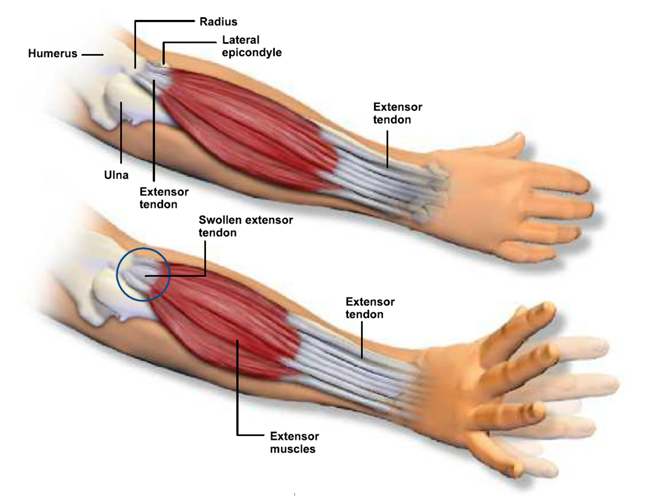Physiotherapy treatments for Tennis Elbow
What is Tennis elbow? Do only tennis players get it?
During tennis, pain would develop as a result of excessive/repetitive wrist extension during backhand shots. If a player had an inadequate technique, they would reach for the ball and flick the racquet through their wrist, instead of getting over the ball and playing through their elbow. Doing this repetitively, would cause strain of the muscles over the elbow joint and eventually lead to pain. Tennis players who play with racquets that are too heavy can also develop this type of injury.
As mentioned, you don’t have to be a tennis player to get this condition. Tennis elbow usually affects men more than women. It most often affects people between the ages of 30 and 50, although people of any age can be affected.
Tennis elbow is caused by any repetitive extension movements of the wrist, especially while gripping something, for example: painting, DIY work with a drill/screwdriver etc. This can cause a progressive injury of the muscle and tendon area around the outside of the elbow. Tennis elbow specifically involves the area where the muscles and tendons of the forearm attach to the outside bony area, also called the lateral epicondyle of the elbow. This is where we get the term ‘lateral epicondylitis’.
In the term epicondylitis, the suffix –itis is used to indicate inflammation. Other examples where this is used is in ‘arthritis’- inflammation of the joints or ‘sinusitis’- inflammation of the sinuses. Interestingly though, the term ‘epicondylitis’ is a misnomer because the pathophysiology does not involve inflammation. The pathophysiology of tennis elbow is degenerative and non-inflammatory.
More recently, when studies of muscles/tendons of people with tennis elbow have been examined under microscope, there has been no evidence found of inflammatory cells. Therefore the pain experienced by people with tennis elbow is believed to be due to repetitive microtrauma/ degeneration of the tendons, rather than inflammation.
The muscles/tendons that are affected by tennis elbow are the muscles which control wrist extension, we call these wrist extensors. These muscles originate at the elbow and insert into the bones on the upper part of the wrist and hand. Therefore when there is an injury to this area that doesn’t involve inflammation, a more accurate term for this condition is ‘common extensor tendinopathy’ and not ‘lateral epicondylitis’.
Signs and symptoms of tennis elbow/ common extensor tendinopathy are:
- Pain slowly increasing around the outside of the elbow, which becomes very tender to touch
- Pain is worsened by shaking hands or squeezing objects.
- Pain is aggravated by extending the wrist against resistance. Examples include: lifting, using tools, opening jars, or even using utensils such as a toothbrush, knife and fork
Another condition, “golfer’s elbow” refers to the same type of injury occurring on the inside of the elbow, this might be referred to as medial epicondylitis. Overuse injury/ microtrauma can also affect the back or posterior part of the elbow as well.
From a physiotherapy point of view, when it comes to tennis elbow, treatment is aimed at optimising the recovery of the injured muscle tendon. Firstly this is achieved by rest from the aggravating condition. Manual treatment techniques to aid recovery include soft tissue release to the affected area, dry needling, strapping followed by specific strengthening exercises and modification of activity to limit reoccurrence of the condition.
If you have any queries, please don’t hesitate to call 011 064 5670 or enquire online

